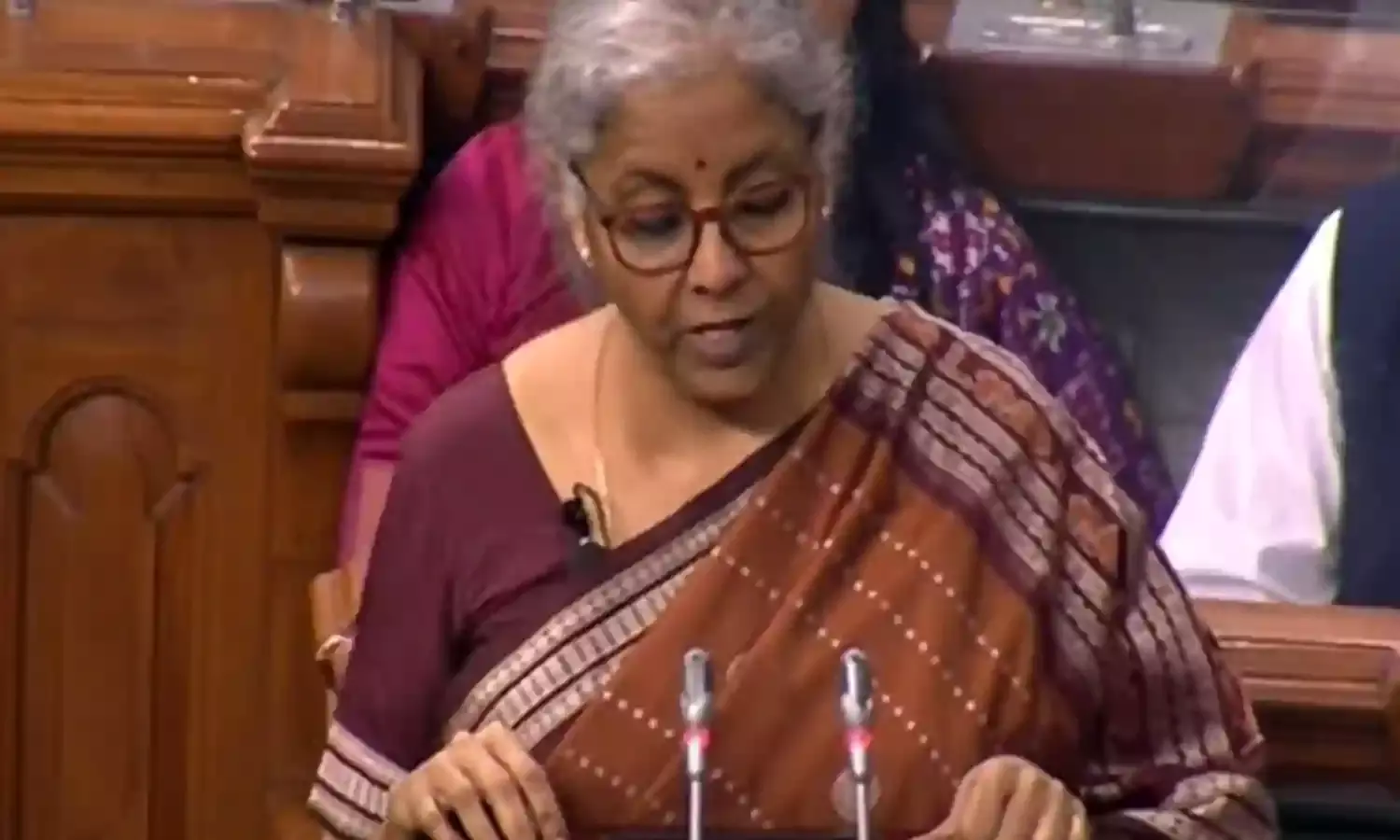Introduction Of New Updated Returns, 30% Tax On Income From Transfer Of Virtual Digital Asset– Key Highlights Of Union Budget 2022-23
The Union Finance Minister Nirmala Sitharaman has today presented the Union Budget 2022-23 while emphasizing upon "Azadi ka Amrit Mahotsav' and stating that India has entered into Amrit Kaal, the 25-year-long leadup to India@100.
The Government did not make any changes to the present income tax slabs.
It is pertinent to note that the finance minister during her speech said –
"The overall, sharp rebound and recovery of the economy is reflective of our country's strong resilience. India's economic growth in the current year is estimated to be 9.2 per cent, highest among all large economies.'
Ms Sitharaman in her 4th Budget speech stressed over the goals which the Government seeks to achieve. They are –
- Complementing the macro-economic level growth focus with a micro-economic level all-inclusive welfare focus,
- Promoting digital economy & fintech, technology enabled development, energy transition, and climate action, and
- Relying on virtuous cycle starting from private investment with public capital investment helping to crowd-in private investment.
Further, the finance minister stated that this budget seeks to lay foundation and give a blueprint to steer the economy over the Amrit Kaal of the next 25 years – from India to 75 to India at 100.
Presenting the budget, she stated that this budget will continue to provide an impetus for growth and will be beneficial for youth, women, farmers and Scheduled Caste and Scheduled Tribes.
The Government through its budget has prioritized –
- PM GatiShakti
- Inclusive Development
- Productivity Enhancement & Investment, Sunrise Opportunities, Energy Transition, and Climate Action and
- Financing of Investments
The key highlights of the budget as presented by the finance minister are –
PART A
- PM GatiShakti
- PM GatiShakti is a transformative approach for economic growth and sustainable development. The approach is driven by seven engines, namely, Roads, Railways, Airports, Ports, Mass Transport, Waterways, and Logistics Infrastructure.
- The scope of PM GatiShakti National Master Plan will encompass the seven engines for economic transformation, seamless multimodal connectivity and logistics efficiency
- PM GatiShakti Master Plan for Expressways will be formulated in 2022-23 to facilitate faster movement of people and goods. The National Highways network will be expanded by 25,000 km in 2022-23. 20,000 crores will be mobilized through innovative ways of financing to complement the public resources.
- Efficient movement of goods through different modes, reducing logistics cost and time, assisting just-in-time inventory management, and eliminating tedious documentation.
- 'One Station-One Product' concept will be popularized to help local businesses & supply chains.
- As a part of Atmanirbhar Bharat, 2,000 km of network will be brought under Kavach, the indigenous world-class technology for safety and capacity augmentation in 2022-23.
- Four hundred new-generation Vande Bharat Trains with better energy efficiency and passenger riding experience will be developed and manufactured during the next three years.
- One hundred PM GatiShakti Cargo Terminals for multimodal logistics facilities will be developed during the next three years.
- Design of metro systems, including civil structures, will be re-oriented and standardized for Indian conditions and needs.
- As a preferred ecologically sustainable alternative to conventional roads in difficult hilly areas, National Ropeways Development Programme will be taken up on PPP mode. Contracts for 8 ropeway projects for a length of 60 km will be awarded in 2022-23.
- Inclusive Development
i) Agriculture
- The procurement of wheat in Rabi 2021-22 and the estimated procurement of paddy in Kharif 2021-22 will cover 1208 lakh metric tonnes of wheat and paddy from 163 lakh farmers.
- 2.37 lakh crore direct payment of MSP value to their accounts.
- Chemical-free Natural Farming will be promoted throughout the country, with a focus on farmers' lands in 5-km wide corridors along river Ganga, at the first stage.
- 2023 has been announced as the International Year of Millets. Support will be provided for post-harvest value addition, enhancing domestic consumption, and for branding millet products nationally and internationally.
- Use of 'Kisan Drones' will be promoted for crop assessment, digitization of land records, spraying of insecticides, and nutrients.
- States will be encouraged to revise syllabi of agricultural universities to meet the needs of natural, zero-budget and organic farming, modern-day agriculture, value addition and management.
- For farmers to adopt suitable varieties of fruits and vegetables, and to use appropriate production and harvesting techniques, our government will provide a comprehensive package with the participation of state governments.
ii) Skill Development
- The National Skill Qualification Framework (NSQF) will be aligned with dynamic industry needs.
- Digital Ecosystem for Skilling and Livelihood – the DESH-Stack e-portal – will be launched. This aims to empower citizens to skill, reskill or upskill through online training. It will also provide API-based trusted skill credentials, payment and discovery layers to find relevant jobs and entrepreneurial opportunities.
- Startups will be promoted to facilitate 'Drone Shakti' through varied applications and for Drone-As-A-Service (DrAAS). In select ITIs, in all states, the required courses for skilling will be started.
iii) Education
- 'One class-one TV channel' programme of PM eVIDYA will be expanded from 12 to 200 TV channels. This will enable all states to provide supplementary education in regional languages for classes 1-12.
- 750 virtual labs in science and mathematics, and 75 skilling e-labs for the simulated learning environment, will be set up in 2022-23.
- High-quality e-content in all spoken languages will be developed for delivery via the internet, mobile phones, TV and radio through Digital Teachers.
- A Digital University will be established to provide access to students across the country for world-class quality universal education with a personalised learning experience at their doorsteps. This will be made available in different Indian languages and ICT formats.
iv) Health
Ayushman Bharat Digital Mission
- An open platform, for the National Digital Health Ecosystem, will be rolled out. It will consist of digital registries of health providers and health facilities, unique health identity, consent framework, and universal access to health facilities.
- To better access quality mental health counselling and care services, a 'National Tele Mental Health Programme' will be launched.
- This will include a network of 23 tele-mental health centres of excellence, with NIMHANS being the nodal centre and the International Institute of Information Technology-Bangalore (IIITB) providing technology support.
v) Women & Housing
- Three schemes, namely, Mission Shakti, Mission Vatsalya, Saksham Anganwadi and Poshan 2.0 were launched recently to provide integrated benefits to women and children.
- Saksham Anganwadis are a new generation anganwadis that have better infrastructure and audio-visual aids, powered by clean energy and providing an improved environment for early child development.
- Two lakh anganwadis will be upgraded under the Scheme.
- The current coverage of Har Ghar, Nal Se Jal is 8.7 crores. Of this 5.5 crore households were provided tap water in the last 2 years itself.
- Allocation of 60,000 crores has been made with an aim to cover 3.8 crore households in 2022-23.
- In 2022-23 80 lakh houses will be completed for the identified eligible beneficiaries of PM Awas Yojana, both rural and urban. 48,000 crore is allocated for this purpose.
- A new scheme, Prime Minister's Development Initiative for NorthEast, PM-DevINE, will be implemented through the North-Eastern Council. It will fund infrastructure, in the spirit of PM GatiShakti, and social development projects based on felt needs of the North-East. An initial allocation of 1,500 crores will be made.
vi) Banking
- In 2022, 100 per cent of 1.5 lakh post offices will come on the core banking system enabling financial inclusion and access to accounts through net banking, mobile banking, ATMs, and also providing online transfer of funds between post office accounts and bank accounts.
- It is proposed to set up 75 Digital Banking Units (DBUs) in 75 districts of the country by Scheduled Commercial Banks.
- The financial support for the digital payment ecosystem announced in the previous Budget will continue in 2022-23. This will encourage further adoption of digital payments. There will also be a focus to promote the use of payment platforms that are economical and user friendly.
- Productivity Enhancement & Investment, Sunrise Opportunities, Energy Transition, and Climate Action
- Productivity Enhancement & Investment
i) Ease of Doing Business 2.0 & Ease of Living
- In recent years, over 25,000 compliances were reduced and 1486 Union laws were repealed.
- For the Amrit Kaal, the next phase of Ease of Doing Business EODB 2.0 and Ease of Living, will be launched.
- A single window portal, PARIVESH, for all green clearances was launched in 2018. Based on the location of units, information about specific approvals will be provided. It will enable application for all four approvals through a single form, and tracking of the process through Centralized Processing Centre-Green (CPC-Green).
- The issuance of e-Passports using embedded chip and futuristic technology will be rolled out in 2022-23 to enhance convenience for the citizens in their overseas travel.
- For urban capacity building, support will be provided to the states. Modernization of building bye-laws, Town Planning Schemes (TPS), and Transit-Oriented Development (TOD) will be implemented.
- The Central Government's financial support for mass transit projects and the AMRUT scheme will be leveraged for the formulation of action plans and their implementation for facilitating TOD and TPS by the states.
- For developing India specific knowledge in urban planning and design, and to deliver certified training in these areas, up to five existing academic institutions in different regions will be designated as centres of excellence.
- These centres will be provided endowment funds of 250 crores each. In addition, AICTE will take the lead to improve syllabi, quality and access of urban planning courses in other institutions.
- Considering the constraint of space in urban areas for setting up charging stations at scale, a battery swapping policy will be brought out and inter-operability standards will be formulated.
- The private sector will be encouraged to develop sustainable and innovative business models for 'Battery or Energy as a Service'
- The adoption or linkage with National Generic Document Registration System (NGDRS) with the 'One-Nation One-Registration Software' will be promoted as an option for uniform process for registration and 'anywhere registration' of deeds & documents.
ii) Corporate
Insolvency and Bankruptcy Code
Necessary amendments in the Code will be carried out to enhance the efficacy of the resolution process and facilitate cross border insolvency resolution.
Accelerated Corporate Exit
- Several IT-based systems have been established for accelerated registration of new companies.
- Now the Centre for Processing Accelerated Corporate Exit (C-PACE) with process re-engineering, will be established to facilitate and speed up the voluntary winding-up of these companies from the currently required 2 years to less than 6 months.
iii) Telecom
- Required spectrum auctions will be conducted in 2022 to facilitate rollout of 5G mobile services within 2022- 23 by private telecom providers
- A scheme for design-led manufacturing will be launched to build a strong ecosystem for 5G as part of the Production Linked Incentive Scheme.
- 5% of annual collections under the Universal Service Obligation Fund will be allocated.
- The contracts for laying optical fibre in all villages, including remote areas, will be awarded under the Bharatnet project through PPP in 2022-23. Completion is expected in 2025.
- Measures will be taken to enable better and more efficient use of the optical fibre.
iv) Defence
- 68% of the capital procurement budget will be earmarked for domestic industry in 2022-23, up from 58 per cent in 2021-22.
- Defence R&D will be opened up for industry, startups and academia with 25 per cent of defence R&D budget earmarked.
- Private industry will be encouraged to take up design and development of military platforms and equipment in collaboration with DRDO and other organizations through SPV model.
- An independent nodal umbrella body will be set up for meeting wide ranging testing and certification requirements.
v) Energy Transition and Climate Action
- To facilitate domestic manufacturing for the ambitious goal of 280 GW of installed solar capacity by 2030, an additional allocation of ` 19,500 crore for Production Linked Incentive for manufacture of high efficiency modules, with priority to fully integrated manufacturing units from polysilicon to solar PV modules, will be made.
- Five to seven per cent biomass pellets will be co-fired in thermal power plants resulting in CO2 savings of 38 MMT annually.
- Saving energy is an important aspect of energy management. Hence, energy efficiency and savings measures will be promoted. This will be done in large commercial buildings through the Energy Service Company (ESCO) business model.
- The policies and required legislative changes to promote agro forestry and private forestry will be brought in. In addition, financial support will be provided to farmers belonging to Scheduled Castes and Scheduled Tribes, who want to take up agro-forestry.
- As a part of the government's overall market borrowings in 2022-23, sovereign Green Bonds will be issued for mobilizing resources for green infrastructure.
vi) Gift City
- World-class foreign universities and institutions will be allowed in the GIFT City to offer courses in Financial Management, FinTech, Science, Technology, Engineering and Mathematics free from domestic regulations, except those by IFSCA to facilitate availability of high-end human resources for financial services and technology.
- An International Arbitration Centre will be set up in the GIFT City for timely settlement of disputes under international jurisprudence.
- Services for global capital for sustainable & climate finance in the country will be facilitated in the GIFT City.
- Venture Capital and Private Equity invested more than ` 5.5 lakh crore last year facilitating one of the largest start-up and growth ecosystem. Scaling up this investment requires a holistic examination of regulatory and other frictions. An expert committee will be set up to examine and suggest appropriate measures.
- For encouraging important sunrise sectors such as Climate Action, Deep-Tech, Digital Economy, Pharma and Agri-Tech, the government will promote thematic funds for blended finance with the government share being limited to 20 per cent and the funds being managed by private fund managers
vii) Financing of Investments & Fiscal Management
- Measures will be taken to enhance financial viability of projects including PPP, with technical and knowledge assistance from multi-lateral agencies.
- Enhancing financial viability shall also be obtained by adopting global best practices, innovative ways of financing, and balanced risk allocation.
- Introduction of Central Bank Digital Currency (CBDC) will give a big boost to digital economy.
- Digital currency will also lead to a more efficient and cheaper currency management system. It is proposed to introduce Digital Rupee, using blockchain and other technologies, to be issued by the Reserve Bank of India starting 2022-23.
- The total expenditure in 2022-23 is estimated at 39.45 lakh crore, while the total receipts other than borrowings are estimated at 22.84 lakh crore.
- The revised Fiscal Deficit in the current year is estimated at 6.9 per cent of GDP as against 6.8 per cent projected in the Budget Estimates. The Fiscal Deficit in 2022-23 is estimated at 6.4 per cent of GDP, which is consistent with the broad path of fiscal consolidation announced by me last year to reach a fiscal deficit level below 4.5 per cent by 2025-26.
"Since 2014 our government's focus has been on empowerment of citizens, especially the poor and the marginalised. Measures have included programmes that have provided housing, electricity, cooking gas, and access to water. We also have programmes for ensuring financial inclusion and direct benefit transfers. We are committed to strengthening the abilities of the poor to tap all opportunities. Our government constantly strives to provide the necessary ecosystem for the middle classes – a vast and wide section which is populated across various middle-income brackets – to make use of the opportunities they so desire."
PART B
i) Direct Tax
- The Minister introduced a new provision permitting taxpayers to file an Updated Return on payment of additional tax.
- This updated return can be filed within two years from the end of the relevant assessment year.
- Will enable the assessee herself to declare the income that she may have missed out earlier while filing her return.
- Reduced Minimum Alternate Tax for Cooperatives to 15%.
- Surcharge on Cooperative Societies reduced to 7% for those having total income of more than 1 crore and up to 10 crores.
- Allow the payment of annuity and lump sum amount to the differently abled dependent during the lifetime of parents/guardians, i.e., on parents/ guardians attaining the age of sixty years.
- To provide equal treatment to both Central and State government employees it is proposed to increase the tax deduction limit from 10 per cent to 14 per cent on employer's contribution to the NPS account of State Government employees as well.
- Eligible start-ups established before 31.3.2022 had been provided a tax incentive for three consecutive years out of ten years from incorporation In view of the Covid pandemic, the Government has extend the period of incorporation of the eligible start-up by one more year, that is, up to 31.03.2023 for providing such tax incentive.
- Any income from transfer of any virtual digital asset shall be taxed at the rate of 30 per cent.
- Taking forward the policy of sound litigation management, the Government has provided that, if a question of law in the case of an assessee is identical to a question of law which is pending in appeal before the jurisdictional High Court or the Supreme Court in any case, the filing of further appeal in the case of this assessee by the department shall be deferred till such question of law is decided by the jurisdictional High Court or the Supreme Court.
ii) Indirect Taxes
- The Government has proposed to phase out the concessional rates in capital goods and project imports gradually and apply a moderate tariff of 7.5 per cent. Certain exemptions for advanced machineries that are not manufactured within the country shall continue.
- A few exemptions are being introduced on inputs, like specialised castings, ball screw and linear motion guide, to encourage domestic manufacturing of capital goods.
- Customs duty on cut and polished diamonds and gemstones is being reduced to 5 per cent.
- Duty on umbrellas is being raised to 20 per cent. Exemption to parts of umbrellas is being withdrawn.
- Exemption is also being rationalised on implements and tools for agri-sector which are manufactured in India.
- Customs duty exemption given to steel scrap last year is being extended for another year to provide relief to MSME secondary steel producers.
- Certain Anti- dumping and CVD on stainless steel and coated steel flat products, bars of alloy steel and high-speed steel are being revoked in larger public interest considering prevailing high prices of metals.
The Finance Minister Nirmala Sithraman thus observed –
"The Productivity Linked Incentive in 14 sectors for achieving the vision of AtmaNirbhar Bharat has received excellent response, with potential to create 60 lakh new jobs, and an additional production of ` 30 lakh crore during next 5 years."
Click here to read/download the Union Budget 2022-23












